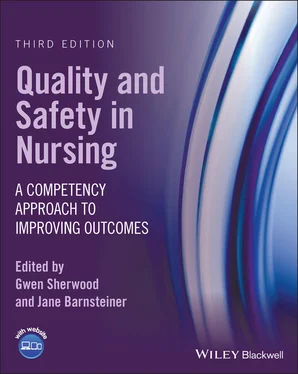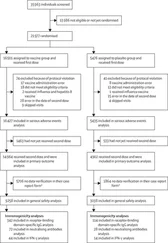Quality and Safety in Nursing
Здесь есть возможность читать онлайн «Quality and Safety in Nursing» — ознакомительный отрывок электронной книги совершенно бесплатно, а после прочтения отрывка купить полную версию. В некоторых случаях можно слушать аудио, скачать через торрент в формате fb2 и присутствует краткое содержание. Жанр: unrecognised, на английском языке. Описание произведения, (предисловие) а так же отзывы посетителей доступны на портале библиотеки ЛибКат.
- Название:Quality and Safety in Nursing
- Автор:
- Жанр:
- Год:неизвестен
- ISBN:нет данных
- Рейтинг книги:5 / 5. Голосов: 1
-
Избранное:Добавить в избранное
- Отзывы:
-
Ваша оценка:
- 100
- 1
- 2
- 3
- 4
- 5
Quality and Safety in Nursing: краткое содержание, описание и аннотация
Предлагаем к чтению аннотацию, описание, краткое содержание или предисловие (зависит от того, что написал сам автор книги «Quality and Safety in Nursing»). Если вы не нашли необходимую информацию о книге — напишите в комментариях, мы постараемся отыскать её.
Quality and Safety in Nursing
Future of Nursing
Quality and Safety in Nursing, Third Edition
Quality and Safety in Nursing — читать онлайн ознакомительный отрывок
Ниже представлен текст книги, разбитый по страницам. Система сохранения места последней прочитанной страницы, позволяет с удобством читать онлайн бесплатно книгу «Quality and Safety in Nursing», без необходимости каждый раз заново искать на чём Вы остановились. Поставьте закладку, и сможете в любой момент перейти на страницу, на которой закончили чтение.
Интервал:
Закладка:
In 2005, the Robert Wood Johnson Foundation funded the Quality and Safety Education for Nurses Project (QSEN) with the aim of transforming nursing education and practice so that nurses include quality and safety in their daily work. Although quality and safety have always been assumed as foundational in nursing education, the intentional integration of specific quality and safety concepts into nursing and other health professions curricula has only primarily occurred since QSEN was launched. This chapter will present a brief historical perspective on patient safety and quality by examining the impact of the IOM Quality Chasm series of reports and subsequent national initiatives, describe the science of patient safety and quality, report driving forces that are pushing the boundaries of patient safety and quality, describe major themes of the newly released national action plan, and examine education as the bridge to improvements. We also introduce the work of the QSEN project in helping lead system changes that are the central theme of this book.
Twenty Years Advancing Quality and Safety
To Err Is Human (IOM, 2000) and the subsequent Quality Chasm series of landmark reports were a wake‐up call for drastic changes in health care delivery ( Textbox 1.1). The series title represents the deep divide between the health care delivered and the health care that is achievable. The commitment to quality and safety must be hardwired into the everyday work of organizations across all levels and in decision‐making to ensure all workers ground their work in quality and safety. To change attitudes and mindsets, quality and safety can never be considered optional work.
The IOM, a think tank of health care experts in the United States, was renamed the National Academy of Medicine in 2015 and will be referred to as NAM for work after 2015.
The Call to Action: Institute of Medicine Quality Chasm Reports
The 2000 release of To Err Is Human instigated a series of IOM reports that provided eye‐opening data on the profusion of defects in health care and heralded ways to improve the system of care. Perhaps most shocking was the estimate that 44,000–98,000 people died each year due to preventable health care harm. Before the 1999 report, preventable harm was cloaked in silence; mistakes were hidden without discussion, patients were informed only when absolutely necessary, and workers were blamed and punished for mistakes. Before the 1999 report, we lacked evidence to determine the scope or depth of system issues that contributed to poor quality and safety outcomes because we lacked local and national reporting systems. To Err Is Human sparked action that gradually brought pressure from regulators, health care purchasers, third‐party payers, and consumers to improve quality and safety outcomes.
Textbox 1.1Summary: The Institute of Medicine Quality Chasm Series
To Err Is Human: Building a Safer Health System (2000)This first IOM report presented the first aggregate data on the depth and breadth of quality and safety issues in US hospitals. Analysis of outcomes from hospitals in Colorado and Utah reported that 44,000 people die each year because of medical errors, while in New York hospitals there are 98,000 deaths. More people die annually from medical error than from motor vehicle accidents, breast cancer, or AIDS. Medical errors are the leading cause of unexpected deaths in health care settings. Communication is the root cause of 65% of sentinel events. The report presents a strategy for reducing preventable medical errors with a goal of a 50% reduction over five years.
Crossing the Quality Chasm: A New Health System for the 21st Century (2001)Recognizing health care organizations as complex systems, the report offers system recommendations to achieve sweeping reform of the American healthcare system: quality problems are pervasive and costly; problems are embedded in the systems themselves, not workers; and major system redesigns hold the most potential for improvement. A set of six health care performance expectations measure patient care outcomes in the STEEEP model ( Figure 1.1). Measures of these six aims align incentives for payment and accountability based on quality outcomes.
Health Professions Education: A Bridge to Quality (2003)Education is declared as the bridge to quality based on five competencies identified as essential for health professionals of the twenty‐first century: patient‐centered care, teamwork and collaboration, evidence‐based practice, quality improvement (and safety, later added as a sixth competency), and informatics. Recommendations include developing a common language to use across disciplines, integrating learning experiences, developing evidence‐based curricula and teaching approaches, initiating faculty development to model the core competencies, and implementing plans to monitor continued proficiency in the competencies.
Keeping Patients Safe: Transforming the Work Environment of Nurses (2004)The 2004 IOM report links nurses’ work environment with patient care safety and quality. Key recommendations helped shaped nurses’ roles in quality and safety, including the importance of creating a satisfying and rewarding work environment, a learning environment, adequate staffing, support from organizational governing boards, and trust between nurses and organizational leaders. Nurses want a voice in shaping the guidelines and policies for their work to incorporate evidence‐based best practices, effective leadership, and interdisciplinary collaboration.
Identifying and Preventing Medication Errors (2006)Medication errors make up the largest category of error, with as many as 3–4% of US patients experiencing a serious medical error while hospitalized, representing huge economic consequences. A national agenda for reducing medication errors would require collaboration from doctors, nurses, pharmacists, the Food and Drug Administration and other government agencies, hospitals and other health care organizations, and patients.
The second report, Crossing the Quality Chasm: A New Health System for the 21st Century (IOM, 2001), issued recommendations for sweeping changes in health care systems and proposed the STEEEP model for system changes ( Figure 1.1). Goals for system changes are outlined in four recommendations that have spurred many initiatives but few broad overarching improvements and still no national leadership group:
Create a national focus through leadership, research, tool kits, and protocols to enhance knowledge about safety.
Identify and learn from errors by establishing a vigorous error‐reporting system to ensure a safer health care system.
Increase standards and expectations for safety improvements through oversight groups, professional organizations, and health care purchasers.
Improve the safety system within health care organizations to ensure that care improves.
The STEEEP model provides a roadmap for care that is safe, timely, effective, efficient, equitable, and patient centered. Still a relevant performance model, these aims provide the measures of quality and accountability that continue to elude health care, particularly considering the impact of social determinants of health inherent in these measures that continue to present inequalities across health care. Measures from the STEEEP model illustrate how health care system fragmentation and decentralization are barriers to safe quality care. Although the United States spends more than any other country on health care, the system has significant shortcomings, across measures of efficiency, quality, access, safety, and affordability (Kurani and Cox, 2020). For example, patients may see multiple providers who may not be able to share critical patient information due to a lack of technology infrastructure, or providers have a feeling of ownership that precludes sharing information or seeking consultation. Although most data are based on acute care in patient settings, errors in physician offices, outpatient settings, nursing homes, and patient homes are even more troubling due to less oversight, fewer reporting structures, and lack of accountability.
Читать дальшеИнтервал:
Закладка:
Похожие книги на «Quality and Safety in Nursing»
Представляем Вашему вниманию похожие книги на «Quality and Safety in Nursing» списком для выбора. Мы отобрали схожую по названию и смыслу литературу в надежде предоставить читателям больше вариантов отыскать новые, интересные, ещё непрочитанные произведения.
Обсуждение, отзывы о книге «Quality and Safety in Nursing» и просто собственные мнения читателей. Оставьте ваши комментарии, напишите, что Вы думаете о произведении, его смысле или главных героях. Укажите что конкретно понравилось, а что нет, и почему Вы так считаете.












